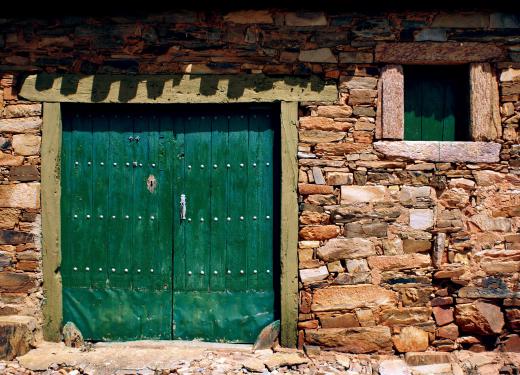A lintel is a structural or decorative architectural feature that spans an opening, such as a door or window. They are used in construction styles from all over the world and throughout history. In the West, they are usually structural in nature, while in Eastern architecture, they are often ornamental, due to differences in building style and technique in these regions. They can vary widely in shape and size, depending on the structure and the builder.
In the West, lintels began appearing in architecture in a widespread way during the classical period, where they were part of a construction technique known as post and lintel, in which supporting posts hold them over openings. The lintel acts as a load-bearing structural member, supporting and distributing the weight above the opening. Examples also pre-date the classical period, and can be seen in many structures built in Europe by early humans.

In the East and regions like South America, these features served a more decorative function. Ornately carved ones were used to add ornamentation to buildings, with weight being supported and distributed in other ways. They were sometimes colored with dyes and paints in addition to being goldleafed and otherwise decorated, just as their counterparts in the West were. People are often surprised to learn that classical Western architecture was actually colorfully painted at the time it was created, even though it's usually left plain white today, and people now associate classical western architecture with stark white structures.
In some structures, invisible lintels are used. These are hidden behind trim and ornaments, supporting weight without being seen. They are often made from sturdy metals that can be bent to make arched or curved openings if desired. When one is visible, sometimes it is carved and ornamented, and in other cases, it may be left plain. The aesthetics of the structure are the determining factor in deciding whether or not it should be visible and what kind of decorations should be present.
When working on a structure with lintels, it is important for a builder to find out if they are load bearing or not. If they are, they need to be removed with care, and it may be necessary to build supportive scaffolding to prevent accidents. If they are decorative, they can safely be removed and changed or replaced without the need for extra precautions. An engineer or architect can evaluate a structure to identify load-bearing structural members for safety before work begins.
Ever since she began contributing to the site several years ago, Mary has embraced the exciting challenge of being a About Mechanics researcher and writer. Mary has a liberal arts degree from Goddard College and spends her free time reading, cooking, and exploring the great outdoors.

